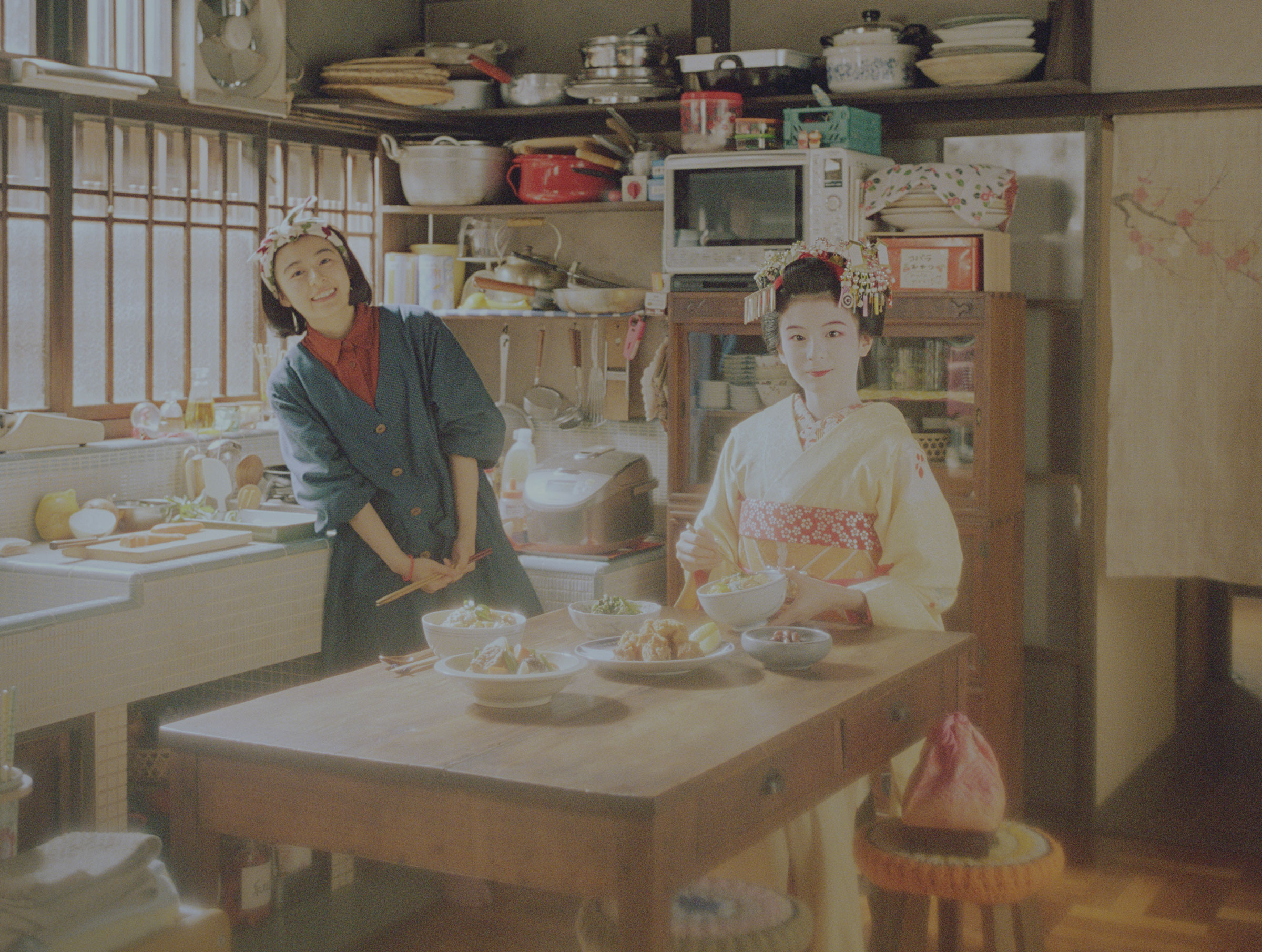Japanese director Hirokazu Kore-eda is not any stranger to worldwide acclaim because the nation’s most distinguished auteur. Two of his works earned awards on the prestigious Cannes Movie Pageant: a Jury Prize for Like Father, Like Son (2013), and the pageant’s grand Palme d’Or prize for Shoplifters (2018)—which was additionally nominated on the 2019 Oscars and Golden Globes for Finest International Language Movie.
Now, he’s turning his focus to the small display screen, as showrunner, author, and director of the brand new Netflix collection The Makanai: Cooking for the Maiko Home, which premiered globally on Jan. 12 and is predicated on a preferred manga in Japan.
The nine-episode collection tells the fictional modern-day story of 16-year-old Kiyo, a northern Japanese native who heads south to Kyoto to turn into a maiko, a younger geiko—the Kyoto-specific time period for geisha, Japanese conventional skilled entertainers. The geiko mentors deem Kiyo unfit as a maiko attributable to her clumsiness, however she earns their hearts because the in-house prepare dinner, or the makanai.
In an interview with TIME, Kore-eda says he had little thought earlier than making the present concerning the heavily-guarded tradition of geiko and maiko, solely having preconceived notions based mostly on classical Japanese administrators’ portrayals of the artwork performers in movies.
“Once I researched the all-women, communal residing quarters, referred to as yakata, in Kyoto, the place this story takes place, I used to be fascinated by how the ladies name one another moms and sisters regardless of having no blood relations,” Kore-eda says. “Their lifestyle impressed me to recreate this world for the display screen.”
The Makanai is a product of the manga second
Due to the facility of the web in enabling more and more world audiences to seek out content material from around the globe, manga (Japanese comics) has seen an increase in reputation amongst non-Japanese readers. Polygon experiences that gross sales of the highest 50 manga titles within the U.S. tripled in 2021. And live-action diversifications are usually not a brand new phenomenon. South Korean director Park Chan-wook’s 2003 movie Oldboy is loosely based mostly on a Japanese manga of the identical title by Garon Tsuchiya. Fringe of Tomorrow, the 2014 Tom Cruise and Emily Blunt sci-fi motion flick, was based mostly on the manga All You Want Is Kill by Hiroshi Sakurazaka.
Manga diversifications geared towards Western audiences, nevertheless, have confirmed to be hit-or-miss. Spike Lee’s 2013 remake of Oldboy was a box-office flop. Netflix’s 2017 live-action film Dying Be aware was virtually universally panned by critics. The 2017 blockbuster Ghost Within the Shell, starring Scarlett Johansson, sparked controversy for white-washing. And the 2009 adaptation of Dragonball is commonly listed among the many worst movies of the early 2000s.
The Makanai is predicated on a best-selling manga by Aiko Koyama entitled Maiko-san chi no makanai-san, first printed in 2016. Koyama’s comedian gained one in all Japan’s time-hallowed manga awards, the Shogakukan Manga Award, in 2020, and has offered over 2.7 million copies. Due to its home reputation, the manga already had an anime collection adaptation, which aired on Japanese nationwide broadcaster NHK World in 2021.
Mass media’s problematic previous depicting the lives of geisha
The lives of Japan’s locally-revered artisans are shrouded in secrecy. Geiko and maiko as occupations date again to the 1600s. However the geisha inhabitants, some 80,000 within the Twenties, is now on the decline, much more so after the COVID-19 pandemic hit. There are estimated to be fewer than 1,000 geisha in Japan as we speak.
In 1997, the world had a rarefied window into geisha life by way of Sayuri: Memoirs of a Geisha, an English novel by Arthur Golden, which finally grew to become a 2005 main movement image by Rob Marshall that controversially starred non-Japanese girls in Japanese roles. However the supply materials itself stirred controversy, too: retired geiko Mineko Iwasaki, whom Golden interviewed to jot down the novel, filed a swimsuit towards him and his writer for supposedly breaking the code of silence about her group. The 2 finally settled out of courtroom.
If there was something Mineko lamented most, it was the novel’s highly-sexualized depiction of geiko. For years, Western media have conflated geisha exercise with dalliance and highly-stylized prostitution. Following the success of Golden’s novel, vacationers fled to geisha districts in Japan, e-book in hand, desirous to catch a glimpse of the ladies. Quickly, geiko in Kyoto’s Gion reported situations of harassment from vacationers who wished footage (amongst different cultural taboos), prompting the district to implement a ban on taking pictures in 2019.
Kore-eda is conscious of the previous controversy and hopes that his collection will do higher, although he additionally hopes that folks don’t confuse fiction for actuality “as soon as once more,” he says. There aren’t any teenage makanai, just like the character Kiyo, for instance. “I heard that as a result of affect of Sayuri: Memoirs of a Geisha, many vacationers from abroad misunderstood that every one maiko have been offered by their mother and father,” Kore-eda tells TIME. “Maybe this collection will at the very least dispel such misconceptions, though I by no means supposed on it.”
The Makanai humanizes geisha tradition principally by way of Sumire, Kiyo’s greatest buddy who trains to be a “one-in-a-million” maiko, and her different housemates, illustrating the trouble and work required to be a maiko, the practices and guidelines and even superstitions they observe—right down to the usage of telephones and fortunate charms, whereas additionally shining mild on the relatable elements of their lives like having crushes, sustaining friendships, and navigating romantic relationships.
The Makanai is finally a narrative about meals
As a narrative about the home makanai—which implies each the prepare dinner and the meal served in a boarding home—Kore-eda’s staff indulged in detailed meals scenes. Meals is a grounding system in lots of the director’s movies, usually used to propel narratives about household. His 2008 function Nonetheless Strolling begins with a mom and daughter getting ready greens collectively. In a cramped shanty in Shoplifters, a motley band of thieves share dinner cooked from stolen groceries.
The opposite administrators working with Kore-eda on the present see it as a celebration of Japan’s meals tradition. Audiences might be handled to Kiyo’s pleasure over produce, and her pleasure after seeing individuals react to meals she ready. Fellow director Takuma Sato says the collection can be a mirrored image of the knowledge of discovering pleasure within the change of meals, garments, and seasons.
Hiroshi Okuyama, one other director of the collection, had learn the manga supply materials and had discovered it influencing his personal cooking. “I used to be making an attempt to mimic Kiyo’s cooking and selecting the higher high quality components,” Hiroshi tells TIME.
Each Hiroshi and Takuma hope whoever watches Makanai will get pleasure from how meals in Japan is handled. Says Takuma: “I’d be glad if the viewers would take note of the elements of consuming that may excite and chill out individuals, and encourage them to suppose what to prepare dinner or what to eat.”
Correction, Jan. 13
The unique model of this text misspelled two names. They’re Aiko Koyama and Hiroshi Okuyama, respectively, not Aiko Kayama and Hiroshi Okayuma.
Contact us at letters@time.com.










